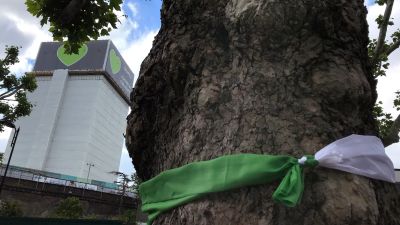Grenfell contractor delegated fire safety to insulation seller, inquiry told

The cladding specialist on the Grenfell Tower refurbishment delegated fire safety checks on the combustible insulation to “the very person who had made it and was selling it”, the inquiry into the blaze has heard.
Ray Bailey, director of external wall fitters Harley Facades, said the firm was “comfortable” using Celotex Rs5000 insulation because it was marketed as having passed the necessary fire test, marketed for use on high-rises, and had been specified for use on the project by the architects Studio E.
But he acknowledged “confusion” over terminology of fire safety ratings, which he said was “quite widespread” throughout the construction industry.
Mr Bailey, who has 35 years’ experience in external wall fitting, told the inquiry on Wednesday: “We were comfortable with Celotex for two reasons. First, the understanding that ‘Class 0 throughout’ meant it was of limited combustibility.
“Secondly in addition to that it had passed an BS8414 test and we sent the details of the cladding system we were using to Celotex for them to approve.
“We were asking Celotex ‘this is what we’re using, are you happy with it?’ And they were.”
Inquiry lawyer Richard Millett QC asked: “Does it come to this – that you were delegating the sign-off or confirmation of the safety of this product to the very person who had made it and was selling it to you?”
Mr Bailey replied: “We wanted Celotex confirmation that they were happy for us to use it.”
Mr Millett said: “Was it not up to Harley to satisfy itself it was safe to use by making the appropriate investigations?”
Mr Bailey replied: “Well we made the investigations with the manufacturer.”
He went on: “The product was specified by Studio E, Exova were their fire consultant so by the time the design was passed down to us Celotex was named.
“We took all proper and necessary means in our view to confirm what they had specified for us was correct.”
The inquiry has heard claims that Celotex targeted the 220ft (67-metre) west London building as a “flagship” project for its Rs5000 insulation, and cynically exploited what one of its bosses called “the smoke of confusion” around building regulations.
Stephanie Barwise QC, a lawyer for a group of survivors and the bereaved, has told the inquiry the firm actively promoted the material despite senior executives knowing it should have been recalled after safety tests.
The flammable rigid foam product was marketed as having a rating of “Class 0 throughout”, a fire safety certificate taken to mean it could be used on external walls of buildings under building regulations.
Mr Bailey said the term “has been used by the manufacturer which has led to the belief that the material is of limited combustibility”, adding that the “throughout” implied all of the product was Class 0, not just the surface.
Mr Millett said it was an “erroneous term” because it equates “limited combustibility throughout with Class 0, which would be correct, with Class 0 throughout with limited combustibility, which would be incorrect.”
Mr Bailey said: “I think this is the confusion… it’s quite widespread throughout the industry.”
Despite Mr Bailey’s assertion that Celotex approved the proposed cladding system at Grenfell, Celotex has said it promoted Rs5000 for use on buildings more than 18m only on a “rainscreen cladding system with the specific components” used when it passed a fire safety test, and that the cladding system at Grenfell “bore no resemblance” to that structure.